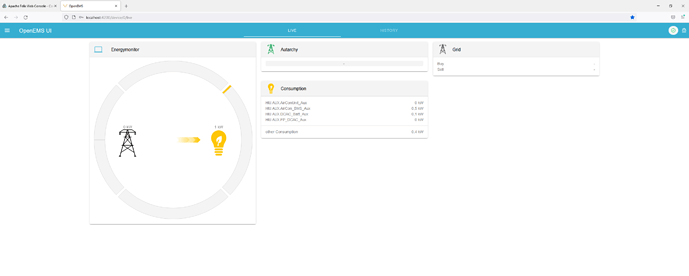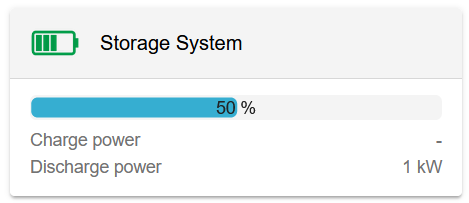Hi Stefan,
thanks for your answer.
But I think I am doing that already, so it should work.
This is the code of the Impl.java (I am not allowed so show you the whole code by uploading it to a GitHub repo)
package io.openems.edge.batteryinverter.kaco.bluestorage;
import org.osgi.service.cm.ConfigurationAdmin;
import org.osgi.service.component.ComponentContext;
import org.osgi.service.component.annotations.Activate;
import org.osgi.service.component.annotations.Component;
import org.osgi.service.component.annotations.ConfigurationPolicy;
import org.osgi.service.component.annotations.Deactivate;
import org.osgi.service.component.annotations.Reference;
import org.osgi.service.component.annotations.ReferenceCardinality;
import org.osgi.service.component.annotations.ReferencePolicy;
import org.osgi.service.component.annotations.ReferencePolicyOption;
import org.osgi.service.event.Event;
import org.osgi.service.event.EventConstants;
import org.osgi.service.event.EventHandler;
import org.osgi.service.metatype.annotations.Designate;
import org.slf4j.Logger;
import org.slf4j.LoggerFactory;
import io.openems.common.exceptions.OpenemsException;
import io.openems.common.exceptions.OpenemsError.OpenemsNamedException;
import io.openems.edge.bridge.modbus.api.AbstractOpenemsModbusComponent;
import io.openems.edge.bridge.modbus.api.BridgeModbus;
import io.openems.edge.bridge.modbus.api.ElementToChannelConverter;
import io.openems.edge.bridge.modbus.api.ElementToChannelScaleFactorConverter;
import io.openems.edge.bridge.modbus.api.ModbusComponent;
import io.openems.edge.bridge.modbus.api.ElementToChannelConverterChain;
import io.openems.edge.bridge.modbus.api.ElementToChannelOffsetConverter;
import io.openems.edge.bridge.modbus.api.ModbusProtocol;
import io.openems.edge.bridge.modbus.api.element.DummyRegisterElement;
import io.openems.edge.bridge.modbus.api.element.SignedDoublewordElement;
import io.openems.edge.bridge.modbus.api.element.SignedWordElement;
import io.openems.edge.bridge.modbus.api.element.StringWordElement;
import io.openems.edge.bridge.modbus.api.element.UnsignedDoublewordElement;
import io.openems.edge.bridge.modbus.api.element.UnsignedWordElement;
import io.openems.edge.bridge.modbus.api.task.FC16WriteRegistersTask;
import io.openems.edge.bridge.modbus.api.task.FC4ReadInputRegistersTask;
import io.openems.edge.common.component.OpenemsComponent;
import io.openems.edge.common.cycle.Cycle;
import io.openems.edge.common.event.EdgeEventConstants;
import io.openems.edge.common.sum.GridMode;
import io.openems.edge.common.taskmanager.Priority;
import io.openems.edge.batteryinverter.api.HIUBatteryInverter;
import io.openems.edge.batteryinverter.kaco.bluestorage.statemachine.Context;
import io.openems.edge.batteryinverter.kaco.bluestorage.statemachine.StateMachine;
import io.openems.edge.batteryinverter.kaco.bluestorage.statemachine.StateMachine.State;
import io.openems.edge.ess.api.SymmetricEss;
@Designate(ocd = Config.class, factory = true)
@Component(//
name = "Battery-Inverter KACO Bluestorage", //
immediate = true, //
configurationPolicy = ConfigurationPolicy.REQUIRE, //
property = {//
EventConstants.EVENT_TOPIC + "=" + EdgeEventConstants.TOPIC_CYCLE_BEFORE_WRITE, //
EventConstants.EVENT_TOPIC + "=" + EdgeEventConstants.TOPIC_CYCLE_BEFORE_PROCESS_IMAGE //
}
)
public class KacoBluestorageImpl extends AbstractOpenemsModbusComponent
implements KacoBluestorage, OpenemsComponent, ModbusComponent, HIUBatteryInverter, EventHandler, SymmetricEss {
private Config config = null;
private final Logger log = LoggerFactory.getLogger(KacoBluestorageImpl.class);
private State[] previousState = {State.UNDEFINED, State.UNDEFINED};
public enum ManualState {
DISCONNECTED,
STANDBY,
RUN
}
@Reference
protected Cycle cycle;
/**
* Manages the {@link State}s of the StateMachine.
* Gives initial state
*/
private final StateMachine stateMachine = new StateMachine(State.UNDEFINED);
/**
* Class for applying the power limit and damp factor
*/
private final PowerLimitAndDamping powerLimitAndDamping = new PowerLimitAndDamping(this);
public KacoBluestorageImpl() {
super(//
OpenemsComponent.ChannelId.values(), //
ModbusComponent.ChannelId.values(), //
HIUBatteryInverter.ChannelId.values(), //
KacoBluestorage.ChannelId.values(), //
SymmetricEss.ChannelId.values() //
);
}
@Reference
protected ConfigurationAdmin cm;
@Reference(policy = ReferencePolicy.STATIC, policyOption = ReferencePolicyOption.GREEDY, cardinality = ReferenceCardinality.MANDATORY)
protected void setModbus(BridgeModbus modbus) {
super.setModbus(modbus);
}
@Activate
void activate(ComponentContext context, Config config) throws OpenemsException {
if(super.activate(context, config.id(), config.alias(), config.enabled(), config.modbusUnitId(), this.cm, "Modbus",
config.modbus_id())) {
return;
}
this.config = config;
}
@Deactivate
protected void deactivate() {
super.deactivate();
}
/**
* Writes and reads all necessary modbus registers.
* <p>
* Gets executed by the system at every cycle parallel and asynchronous to the data processing.
* Synchronization at the end of the cycle
* <p>
* For the values with scale factor the scale factor get applied right when reading (if the scale factor would be applied later,
* it would case a delay on one cycle until the values are available) <br>
* For that the scale factor gets read from its channel. So in case of an switch in the scale factor, for one cycle the old, wrong scale factor will be applied.
*/
@Override
protected ModbusProtocol defineModbusProtocol() throws OpenemsException {
return new ModbusProtocol(this,
// starts with writing the values given by the controller and state machine
new FC16WriteRegistersTask(152,
m(HIUBatteryInverter.ChannelId.p_ac_dcacbatt_target, new UnsignedWordElement(152),
ElementToChannelConverter.DIRECT_1_TO_1)),
new FC16WriteRegistersTask(158,
m(HIUBatteryInverter.ChannelId.run_batt_system, new UnsignedWordElement(158),
ElementToChannelConverter.DIRECT_1_TO_1)),
// KACO C001
new FC4ReadInputRegistersTask(20, Priority.HIGH,
m(HIUBatteryInverter.ChannelId.Model_dcacbatt_raw, new StringWordElement(20, 16)),
new DummyRegisterElement(36, 43),
m(HIUBatteryInverter.ChannelId.SW_version_dcacbatt_raw, new StringWordElement(44, 8),
ElementToChannelConverter.DIRECT_1_TO_1)),
// KACO I103
new FC4ReadInputRegistersTask(72, Priority.HIGH,
m(HIUBatteryInverter.ChannelId.i_tot_ac_dcacbatt_act, new UnsignedWordElement(72),
new ElementToChannelScaleFactorConverter(this, HIUBatteryInverter.ChannelId.A_scale_factor_raw)),
m(HIUBatteryInverter.ChannelId.i_l1_ac_dcacbatt_act, new UnsignedWordElement(73),
new ElementToChannelScaleFactorConverter(this, HIUBatteryInverter.ChannelId.A_scale_factor_raw)),
m(HIUBatteryInverter.ChannelId.i_l2_ac_dcacbatt_act, new UnsignedWordElement(74),
new ElementToChannelScaleFactorConverter(this, HIUBatteryInverter.ChannelId.A_scale_factor_raw)),
m(HIUBatteryInverter.ChannelId.i_l3_ac_dcacbatt_act, new UnsignedWordElement(75),
new ElementToChannelScaleFactorConverter(this, HIUBatteryInverter.ChannelId.A_scale_factor_raw)),
m(HIUBatteryInverter.ChannelId.A_scale_factor_raw, new SignedWordElement(76),
ElementToChannelConverter.DIRECT_1_TO_1),
new DummyRegisterElement(77, 79),
m(HIUBatteryInverter.ChannelId.u_l1_ac_dcacbatt_act, new UnsignedWordElement(80),
new ElementToChannelScaleFactorConverter(this, HIUBatteryInverter.ChannelId.V_scale_factor_raw)),
m(HIUBatteryInverter.ChannelId.u_l2_ac_dcacbatt_act, new UnsignedWordElement(81),
new ElementToChannelScaleFactorConverter(this, HIUBatteryInverter.ChannelId.V_scale_factor_raw)),
m(HIUBatteryInverter.ChannelId.u_l3_ac_dcacbatt_act, new UnsignedWordElement(82),
new ElementToChannelScaleFactorConverter(this, HIUBatteryInverter.ChannelId.V_scale_factor_raw)),
m(HIUBatteryInverter.ChannelId.V_scale_factor_raw, new SignedWordElement(83),
ElementToChannelConverter.DIRECT_1_TO_1),
m(HIUBatteryInverter.ChannelId.p_ac_dcacbatt_act, new UnsignedWordElement(84),
new ElementToChannelScaleFactorConverter(this, HIUBatteryInverter.ChannelId.W_scale_factor_raw)),
m(HIUBatteryInverter.ChannelId.W_scale_factor_raw, new SignedWordElement(85),
ElementToChannelConverter.DIRECT_1_TO_1),
m(HIUBatteryInverter.ChannelId.freq_ac_dcacbatt_act, new UnsignedWordElement(86),
new ElementToChannelScaleFactorConverter(this, HIUBatteryInverter.ChannelId.Hz_scale_factor_raw)),
m(HIUBatteryInverter.ChannelId.Hz_scale_factor_raw, new SignedWordElement(87),
ElementToChannelConverter.DIRECT_1_TO_1),
new DummyRegisterElement(88, 93),
m(HIUBatteryInverter.ChannelId.e_tot_dcacbatt_act, new SignedDoublewordElement(94),
new ElementToChannelScaleFactorConverter(this, HIUBatteryInverter.ChannelId.WH_scale_factor_raw)),
m(HIUBatteryInverter.ChannelId.WH_scale_factor_raw, new SignedWordElement(96),
ElementToChannelConverter.DIRECT_1_TO_1),
new DummyRegisterElement(97, 102),
m(HIUBatteryInverter.ChannelId.temp_cab_dcacbatt_act, new UnsignedWordElement(103),
new ElementToChannelConverterChain(new ElementToChannelScaleFactorConverter(
this, HIUBatteryInverter.ChannelId.Tmp_scale_factor_raw),
new ElementToChannelOffsetConverter(273))),
new DummyRegisterElement(104, 106),
m(HIUBatteryInverter.ChannelId.Tmp_scale_factor_raw, new SignedWordElement(107),
ElementToChannelConverter.DIRECT_1_TO_1),
m(HIUBatteryInverter.ChannelId.status_dcacbatt, new UnsignedWordElement(108),
ElementToChannelConverter.DIRECT_1_TO_1),
new DummyRegisterElement(109),
m(HIUBatteryInverter.ChannelId.error_dcacbatt, new UnsignedDoublewordElement(110),
ElementToChannelConverter.DIRECT_1_TO_1)),
// KACO IC120
new FC4ReadInputRegistersTask(125, Priority.HIGH,
m(HIUBatteryInverter.ChannelId.p_dcacbatt_nom, new UnsignedWordElement(125),
new ElementToChannelScaleFactorConverter(this, HIUBatteryInverter.ChannelId.WRtg_scale_factor_raw)),
m(HIUBatteryInverter.ChannelId.WRtg_scale_factor_raw, new SignedWordElement(126),
ElementToChannelConverter.DIRECT_1_TO_1),
m(HIUBatteryInverter.ChannelId.s_dcacbatt_nom, new UnsignedWordElement(127),
new ElementToChannelScaleFactorConverter(this, HIUBatteryInverter.ChannelId.VARtg_scale_factor_raw)),
m(HIUBatteryInverter.ChannelId.VARtg_scale_factor_raw, new SignedWordElement(128),
ElementToChannelConverter.DIRECT_1_TO_1),
new DummyRegisterElement(129, 133),
m(HIUBatteryInverter.ChannelId.i_rms_dcacbatt_nom, new UnsignedWordElement(134),
new ElementToChannelScaleFactorConverter(this, HIUBatteryInverter.ChannelId.ARtg_scale_factor_raw)),
m(HIUBatteryInverter.ChannelId.ARtg_scale_factor_raw, new SignedWordElement(135),
ElementToChannelConverter.DIRECT_1_TO_1),
new DummyRegisterElement(136, 140),
m(HIUBatteryInverter.ChannelId.e_batt_nom, new UnsignedWordElement(141),
new ElementToChannelScaleFactorConverter(this, HIUBatteryInverter.ChannelId.WHRtg_scale_factor_raw)),
m(HIUBatteryInverter.ChannelId.WHRtg_scale_factor_raw, new SignedWordElement(142),
ElementToChannelConverter.DIRECT_1_TO_1),
m(HIUBatteryInverter.ChannelId.capa_batt_nom, new UnsignedWordElement(143),
new ElementToChannelScaleFactorConverter(this, HIUBatteryInverter.ChannelId.AhrRtg_scale_factor_raw)),
m(HIUBatteryInverter.ChannelId.AhrRtg_scale_factor_raw, new SignedWordElement(144),
ElementToChannelConverter.DIRECT_1_TO_1),
m(HIUBatteryInverter.ChannelId.p_batt_chg_max_nom, new UnsignedWordElement(145),
new ElementToChannelScaleFactorConverter(this, HIUBatteryInverter.ChannelId.MaxChaRte_scale_factor_raw)),
m(HIUBatteryInverter.ChannelId.MaxChaRte_scale_factor_raw, new SignedWordElement(146),
ElementToChannelConverter.DIRECT_1_TO_1),
m(HIUBatteryInverter.ChannelId.p_batt_dis_max_nom, new UnsignedWordElement(147),
new ElementToChannelScaleFactorConverter(this, HIUBatteryInverter.ChannelId.MaxDisChaRte_scale_factor_raw)),
m(HIUBatteryInverter.ChannelId.MaxDisChaRte_scale_factor_raw, new SignedWordElement(148),
ElementToChannelConverter.DIRECT_1_TO_1)),
// KACO IC121
new FC4ReadInputRegistersTask (152, Priority.HIGH,
m(HIUBatteryInverter.ChannelId.p_ac_dcacbatt_target, new UnsignedWordElement(152),
ElementToChannelConverter.SCALE_FACTOR_MINUS_2),
new DummyRegisterElement(153, 157),
m(HIUBatteryInverter.ChannelId.run_batt_system, new UnsignedWordElement(158),
ElementToChannelConverter.DIRECT_1_TO_1),
m(HIUBatteryInverter.ChannelId.status_batt_system, new UnsignedWordElement(159),
ElementToChannelConverter.DIRECT_1_TO_1)),
// KACO IC124
new FC4ReadInputRegistersTask (166, Priority.HIGH,
m(HIUBatteryInverter.ChannelId.p_batt_chg_max_act, new UnsignedWordElement(166),
new ElementToChannelScaleFactorConverter(this, HIUBatteryInverter.ChannelId.Wmax_scale_factor_raw)),
m(HIUBatteryInverter.ChannelId.p_batt_dis_max_act, new UnsignedWordElement(167),
new ElementToChannelScaleFactorConverter(this, HIUBatteryInverter.ChannelId.Wmax_scale_factor_raw)),
m(HIUBatteryInverter.ChannelId.soc_batt_act, new UnsignedWordElement(168),
new ElementToChannelScaleFactorConverter(this, HIUBatteryInverter.ChannelId.SOPct_scale_factor_raw)),
m(HIUBatteryInverter.ChannelId.soh_batt_act, new UnsignedWordElement(169),
new ElementToChannelScaleFactorConverter(this, HIUBatteryInverter.ChannelId.SOPct_scale_factor_raw)),
m(HIUBatteryInverter.ChannelId.u_batt_chg_act, new UnsignedWordElement(170),
new ElementToChannelScaleFactorConverter(this, HIUBatteryInverter.ChannelId.BatV_scale_factor_raw)),
m(HIUBatteryInverter.ChannelId.u_batt_dis_act, new UnsignedWordElement(171),
new ElementToChannelScaleFactorConverter(this, HIUBatteryInverter.ChannelId.BatV_scale_factor_raw)),
m(HIUBatteryInverter.ChannelId.u_batt_act, new UnsignedWordElement(172),
new ElementToChannelScaleFactorConverter(this, HIUBatteryInverter.ChannelId.BatV_scale_factor_raw)),
m(HIUBatteryInverter.ChannelId.i_batt_act, new SignedWordElement(173),
new ElementToChannelScaleFactorConverter(this, HIUBatteryInverter.ChannelId.BatA_scale_factor_raw)),
m(HIUBatteryInverter.ChannelId.u_cell_max_batt_act, new UnsignedWordElement(174),
new ElementToChannelScaleFactorConverter(this, HIUBatteryInverter.ChannelId.CellV_scale_factor_raw)),
m(HIUBatteryInverter.ChannelId.u_cell_min_batt_act, new UnsignedWordElement(175),
new ElementToChannelScaleFactorConverter(this, HIUBatteryInverter.ChannelId.CellV_scale_factor_raw)),
m(HIUBatteryInverter.ChannelId.temp_cell_max_batt_act, new UnsignedWordElement(176),
new ElementToChannelConverterChain(new ElementToChannelScaleFactorConverter(this, HIUBatteryInverter.ChannelId.Tmp2_scale_factor_raw),
new ElementToChannelOffsetConverter(273))),
m(HIUBatteryInverter.ChannelId.temp_cell_min_batt_act, new UnsignedWordElement(177),
new ElementToChannelConverterChain(new ElementToChannelScaleFactorConverter(this, HIUBatteryInverter.ChannelId.Tmp2_scale_factor_raw),
new ElementToChannelOffsetConverter(273))),
m(HIUBatteryInverter.ChannelId.status_batt, new UnsignedWordElement(178),
ElementToChannelConverter.DIRECT_1_TO_1),
new DummyRegisterElement(179),
m(HIUBatteryInverter.ChannelId.warning_batt, new UnsignedDoublewordElement(180),
ElementToChannelConverter.DIRECT_1_TO_1),
m(HIUBatteryInverter.ChannelId.error_batt, new UnsignedDoublewordElement(182),
ElementToChannelConverter.DIRECT_1_TO_1),
m(HIUBatteryInverter.ChannelId.Wmax_scale_factor_raw, new SignedWordElement(184),
ElementToChannelConverter.DIRECT_1_TO_1),
m(HIUBatteryInverter.ChannelId.SOPct_scale_factor_raw, new SignedWordElement(185),
ElementToChannelConverter.DIRECT_1_TO_1),
m(HIUBatteryInverter.ChannelId.BatV_scale_factor_raw, new SignedWordElement(186),
ElementToChannelConverter.DIRECT_1_TO_1),
m(HIUBatteryInverter.ChannelId.BatA_scale_factor_raw, new SignedWordElement(187),
ElementToChannelConverter.DIRECT_1_TO_1),
m(HIUBatteryInverter.ChannelId.CellV_scale_factor_raw, new SignedWordElement(188),
ElementToChannelConverter.DIRECT_1_TO_1),
m(HIUBatteryInverter.ChannelId.Tmp2_scale_factor_raw, new SignedWordElement(189),
ElementToChannelConverter.DIRECT_1_TO_1))
);
}
/**
* Gets executed by the system at every cycle parallel and asynchronous to modbus communication <br>
* Handles the data processing and the state machine for the inverter
* <p>
* The processing of the values gets done at {@link EdgeEventConstants#TOPIC_CYCLE_BEFORE_PROCESS_IMAGE} <br>
* Which means right before the channels values get set for the next cycle. This way the values are as new as possible
* <p>
* The Inverter State machine gets executed at {@link EdgeEventConstants#TOPIC_CYCLE_BEFORE_WRITE} <br>
* Which means after all the controllers and right before the write values get written. This way the calculated values get written right away.
*/
@Override
public void handleEvent(Event event) {
if (!this.isEnabled()) {
return;
}
switch (event.getTopic()) {
case EdgeEventConstants.TOPIC_CYCLE_BEFORE_PROCESS_IMAGE:
// Processing of the _raw values gotten from Battery-Inverter
// processes values get written in channels for other components so use
this.processRawValues();
// writing dummy values into the symmetricEss channels for testing with UI
// this._setSoc(Math.round(this.get_soc_batt_act().get()));
this._setSoc(50);
this._setCapacity(76000);
this._setGridMode(GridMode.UNDEFINED);
this._setActivePower(1000);
this._setReactivePower(0);
this._setMaxApparentPower(60000);
this._setActiveChargeEnergy(0);
this._setActiveDischargeEnergy(0);
this._setMaxCellVoltage(4);
this._setMinCellVoltage(3);
this._setMaxCellTemperature(300);
this._setMinCellTemperature(200);
break;
case EdgeEventConstants.TOPIC_CYCLE_BEFORE_WRITE:
// Check if power target from Controller is within the Limits and apply a damping factor if necessary
int powerTargetChecked = powerLimitAndDamping.checkValue(this.getNextPowerValueUnchecked(), cycle.getCycleTime());
// Prepare Context for state machine
// always use powerTragetchecked as transfer parameter. In manual mode this Value doesn't get used and the manual power target from config is used
Context context = new Context(this, this.config, this.get_status_batt_system().get(), powerTargetChecked, previousState[1], cycle.getCycleTime(), this.getNextControllerStateRequest());
System.out.println("state requested by controller: " + this.getNextControllerStateRequest());
// Calling the state machine
// Inside the state machine the write Values for p_ac_dcacbatt_target and run_batt_system get set.
try {
this.stateMachine.run(context);
// saving the state for next iteration
// needs to be an array of to values, because the state machine goes through 2 states when is runs:
// run: state -> runAndGetNextSate -> new state
previousState[1] = previousState[0];
previousState[0] = this.stateMachine.getCurrentState();
// setting the write Values
if (config.manualInput()) {
// In case of manual Input set the manually given power target
// applying scale factor (hardcoded because it doesn't change)
this.setNext_p_ac_dcacbatt_target((int) (this.config.manualPowerTarget() * Math.pow(10, -2)));
// writing the value in a channel for the database component to read
this.set_p_ac_dcacbatt_target_set(this.config.manualPowerTarget());
System.out.println("Battery Inverter power target write: " + this.config.manualPowerTarget());
}
else {
// else use the target from the limit controller
// applying scale factor (hardcoded because it doesn't change)
this.setNext_p_ac_dcacbatt_target((int) (powerTargetChecked * Math.pow(10, -2)));
// writing the value in a channel for the database component to read
this.set_p_ac_dcacbatt_target_set(powerTargetChecked);
System.out.println("Battery Inverter power target write: " + powerTargetChecked);
}
this.setNext_run_batt_system(this.getSetState());
// writing the value in a channel for the database component to read
this.set_run_batt_system_set(this.getSetState());
System.out.println("Battery Inverter send state: " + this.getSetState());
} catch (OpenemsNamedException e) {
this.logError(log, "State Machine Error: " + e.getMessage());
// if state machine failed always set power target to 0 and state to fault
try {
setNext_run_batt_system(7);
setNext_p_ac_dcacbatt_target(0);
} catch (OpenemsNamedException e1) {
e1.printStackTrace();
}
}
catch (IllegalArgumentException e) {
e.getMessage();
// if state machine failed always set power target to 0 and state to fault
try {
setNext_run_batt_system(7);
setNext_p_ac_dcacbatt_target(0);
} catch (OpenemsNamedException e1) {
e1.printStackTrace();
}
}
break;
}
}
/**
* Strings new to be processes to correct the character order, because the get read wrong <br>
* (I didn't find a way to fix the reading)
*/
private void processRawValues() {
// gets the read out value (as a string, not a value object)
// applies fixChaarcterOrder function
// and sets that fixed String as next Value for the channel (which can be read by other components)
this.setNext_Model_dcacbatt(fixCharacterOrder(this.get_Model_dcacbatt_raw().asString()));
this.setNext_SW_version_dcacbatt(fixCharacterOrder(this.get_SW_version_dcacbatt_raw().asString()));
}
/**
* fixes the character order of a String, if always the to consecutive characters are switched <br>
* e.g. turns String 21436587 into 12345678
*/
private String fixCharacterOrder (String stringWrongOrder) {
// turn string into char array to be able to switch characters individually
char[] charWrongOrder = stringWrongOrder.toCharArray();
// create new char array of same size to safe fixed order
char[] charWrightOrder = new char[charWrongOrder.length];
// changes the order of the to consecutive characters
for (int i = 1; i < (charWrongOrder.length/2)+1; i++) {
charWrightOrder[2*i-2] = charWrongOrder[2*i-1];
charWrightOrder[2*i-1] = charWrongOrder[2*i-2];
}
String stringWrightOrder = new String(charWrightOrder);
return stringWrightOrder;
}
@Override
public String debugLog() {
return ", V1: " + get_u_l1_ac_dcacbatt_act().get() + ", status_bat_system: "
+ get_status_batt_system().asString() + ", manual Input: " + this.config.manualInput()
+ ", e_tot_dcacbatt_act: " + get_e_tot_dcacbatt_act().asString() + ", temp_cab_dcacbatt_act: "
+ this.get_temp_cab_dcacbatt_act().get() + ", Model Number: " + this.get_Model_dcacbatt();
}
}
And my UI looks like this:
(I also have some other meter components running)
The Ess doesn’t show up as you can see.
Is there any further advise you can give me?
Thanks in advance!
Tobi


